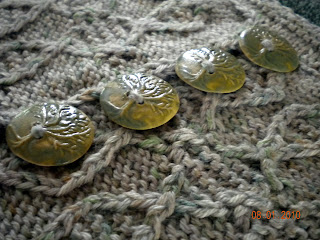I kept notes of what I did as I knit it, and I would say it turned out to be an xsmall-small size. If I could knit it again, I would definitely start with less stitches (I would give it about 2 inches more negative ease) and start the decreases about an inch sooner (although if it was slimmer probably wouldn't need to do that). The yarn is very stretchy, the tweed yarn that I used I mean, so it really has a lot of spring and sproing and give.
Check out the buttons I found! I really love these... these are stones from a beach in southern California. Hand-drilled to make them into buttons. The organic energies of these buttons feels so great on my sweater! When you touch them, you can almost feel like you hear the waves splashing gently on the shore...
You can find these buttons by a wonderful Etsy artist, Made For Fun . Not only are her stones reasonably priced, and well-made, but they came packaged & wrapped beautifully, and with a couple of extra buttons to boot!
I love to buy local when I can, and definitely hand-made when I can... I'm always on the lookout for local or other hand-made artisans of every type, buttons, beads, fibers (I love finding great yarn/roving bases for dyeing!), or anything else. Drop me a line if you are a hand-made artisan so we can talk :)
OK, so onto the rest of the pattern and pictures.....
 |
| I'm very happy with the fit around the wait and hips |


 |
| Perfect Fall outfit is complete with this quick and cozy knit... |
Now... onto the pattern I ended up working out for this sweater. You can find the original pattern here on the web, and here on Ravelry. I looked over Raptwithfiber's notes and then started off on my journey on making it fit for me.
I choose to use two worsted wools held together:
Araucania Nature Wool & Plymouth Tweed
I started with a size #10 needle, but switched to a #9 needle. I would suggest using the #9 for the whole way. I just didn't want to tear it all back out again and thought it would be OK like it was. Knit back & forth on circulars. The edging with the buttons/buttonholes is knit in garter stitch, so you will be knitting the last 6 sts no matter which side you're on (WS or RS).
WindingRiver Buttony Cardigan








